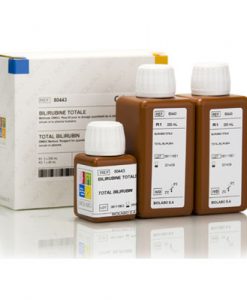Cromatest Creatinine Biochemistry Reagent – 200 Test
৳ 1,288৳ 1,500 (-14%)
In stock
Packaging Size: 2 x 125ml+5ml Cal
Origin: Spain
Brand : Cromatest / Linear
Packaging Type: Bottle
Test/Pack: 250 Test
Method: Kinetic colorimetric method (FIXED TIME)
Cromatest Creatinine Biochemistry Reagent – 250 Test
PRINCIPLE:
This procedure is based upon a modification of the original picrate reaction (Jaffe)1. Creatinine under alkaline conditions reacts with picrate ions forming a reddish complex. The formation rate of the complex measured through the increase of absorbance in a prefixed interval of time is proportional to the concentration of creatinine in the sample.2-4
REAGENT COMPOSITION:
R1 – Picric acid. Picric acid 25 mmol/L
R2 – Alkaline buffer. Phosphate buffer 300 mmol/L pH 12.7, SDS 2.0 g/L (w/v). Xi R:36/37/38
CAL – Creatinine standard. Creatinine 2 mg/dL (177 mmol/L). Organic matrix-based primary standard.
Working reagent. Mix 1 volume of R1 + 1 volume of R2. Stable for 1 week at room temperature, stored tightly closed and protected from light.
STORAGE AND STABILITY:
Store at 15-30ºC.
The reagents are stable until the expiry date stated on the label, stored tightly closed and protected from light.
SAMPLES:
Serum or heparinized plasma, and urine (see Notes).
Creatinine in serum or plasma is stable for up to 24 hours at 2-8ºC. Freeze for longer storage.
Creatinine from random samples of urine is stable for 4 days at 2- 8ºC. Freeze for longer storage. The 24-hour urine samples for the Clearance Test should be collected on a preservative (fluoride- thymol) and immediately refrigerated.
INTERFERENCES:
The non-specific color formation from proteins and carbohydrates is suppressed by the alkaline SDS-borate buffer.
The oxidant prevents negative bilirubin interference. Triglycerides up to 2 g/L do not interfere.
A number of drugs are known to affect creatinine levels.5
MATERIALS REQUIRED:
Photometer or colorimeter with a thermostatted cell compartment, able of reading at 500 ± 10 nm.
Constant temperature incubator set at 37ºC. Stopwatch, strip-chart recorder or printer.
Cuvettes with 1 cm path length.
Pipettes to measure reagents and samples.

PROCEDURE:
| 1.
2. 3. |
Preincubate working reagent, samples, and standard to reaction temperature (37ºC).
Set the photometer to 0 absorbances with distilled water. Pipette into a cuvette. |
| Working reagent Sample or Standard | 1.0 mL 100 mL |
Record absorbance at 500 nm after 30 seconds (A1) and after 90 seconds (A2) of the sample or standard addition.
Calculations:
Samples with concentrations higher than 20 mg/dL should be diluted 1:4 with saline and assayed again. Multiply the results by 4.
If results are to be expressed as SI units apply mg/dL x 88.4 = mmol/L
REFERENCE VALUES:
Serum, plasma:
| Men | 0.70-1.20 mg/dL (62-106 mmol/L) |
| Women | 0.50-0.90 mg/dL (44-80 mmol/L) |
Urine:
| Men | 14-26 mg/Kg/24-h (124-230 mmol/Kg/24-h) |
| Women | 11-20 mg/Kg/24-h (97-117 mmol/Kg/24-h) |
Clearance Test:
| Men | 97-137 mL/min |
| Women | 88-128 mL/min |
It is recommended that each laboratory establishes its own reference range.
QUALITY CONTROL:
The use of a standard to calculate results allows for obtaining accuracy independent of the system or instrument used.
To ensure adequate quality control (QC), each run should include a set of controls (normal and abnormal) with assayed values handled as unknowns.
Buy Hematology Analyzer Reagent ar best price from Medistore
CLINICAL SIGNIFICANCE:
Creatinine is synthesized in the body at a fairly constant rate from creatine, which is produced during muscle contractions from creatine phosphate. Creatinine in the blood is then removed by filtration through the glomeruli of the kidney for excretion in the urine. Since the excretion of creatinine in healthy individuals is independent of diet and thus relatively constant, the creatinine clearance (CC) test is one of the most sensitive tests to diagnose renal function, especially the glomerular filtration rate (GFR) the concentration of creatinine in serum being dependent almost entirely upon its rate of excretion by the kidney.
Elevated levels of creatinine in serum are usually associated with renal diseases, especially those related to GFR such as glomerular nephritis. Therefore, the clinical significance of the creatinine level in plasma or serum is usually determined in conjugation with the plasma urea level since there is an increase in both levels in postrenal azotemia, while the CC, or urine levels, are diminished.
NOTES:
Creatinine in urine may be assayed on fresh random samples. No special preparation of the patient is needed. Dilute specimen
1:50 with distilled water before the assay. Multiply the result by 50.
ANALYTICAL PERFORMANCE:
- LInearity:Up to 20 mg/dL
- Precision
mg/dL Intraserial Interserial Media 0.8 4.9 0.8 4.9 DE 0.05 0.1 0.06 0.15 CV% 6.25 2.04 7.5 3.06 N 10 10 5 5 - Replicates 5 for each level.
- Replicates 5 for each level Instrument: CECIL CE 2021 for 8 days.
- Sensitivity. Using this reagent and method a DA/min of 020 read at 500 nm is equivalent to 1 mg of creatinine/dL.
- Correlation. This assay (y) was compared with a similar commercial method (x). The results were:
N = 25 r = 0.997 y = 1.025x + 0.012
REFERENCES:
- 1. Jaffe, M.Z. Physiol. Chem. 10 : 391 (1886).
- 2. Bartels, H., and Böhner, M. Clin. Chim. Acta. 32 : 81 (1971). Larsen, K. Clin. Chim. Acta. 41 : 209 (1972).
- 3. Heinegaard, D., and Tinderstrom, G. Clin. Chim. Acta. 43 : 305 (1973).
- 4. Young, D.S., Pestaner, LG. and Gibberman, P. Clin. Chem. 21, Vol. 5, 10-432D (1975).
- 5. Tietz. N.W. Clinical Guide to Laboratory Tests, 3rd Edition.
- 6. W.B. Saunders Co. Philadelphia, PA. (1995).
Best Quality Diagnostic Products Buy from Medistore
Brand
Chromatest
You must be logged in to post a review.







Reviews
There are no reviews yet.